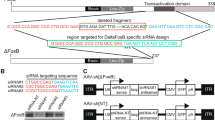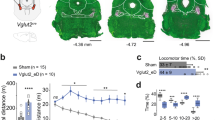Abstract
In this study, we report the amelioration of parkinsonian symptoms in rat Parkinson's disease (PD) models, as a result of the expression of glutamate decarboxylase (GAD) 65 with a modified cytomegalovirus (CMV) promoter. The transfer of the gene for gamma-amino butryic acid (GAD), the rate-limiting enzyme in gama-amino butrylic acid (GABA) production, has been investigated as a means to increase inhibitory synaptic activity. Electrophysiological evidence suggests that the transfer of the GAD65 gene to the subthalamic nucleus (STN) can change the excitatory output of this nucleus to inhibitory output. Our in vitro results also demonstrated higher GAD65 expression in cells transfected with the JDK promoter, as compared to cells transfected with the CMV promoter. Also, a rat PD model in which recombinant adeno-associated virus-2 (rAAV2)-JDK-GAD65 was delivered into the STN exhibited significant behavioral improvements, as compared to the saline-injected group. Interestingly, we observed that these behavioral improvements were more obvious in rat PD models in which rAAV2-JDK-GAD65 was injected into the STN than in rat PD models in which rAAV2-CMV-GAD65 was injected into the STN. Moreover, according to electrophysiological data, the rAAV2-JDK-GAD65-injected group exhibited more constant improvements in firing rates than did the rAAV2-CMV-GAD65-injected group. These data indicate that the JDK promoter, when coupled with GAD65 expression, is more effective with regard to parkinsonian symptoms than is the CMV promoter.
This is a preview of subscription content, access via your institution
Access options
Subscribe to this journal
Receive 12 print issues and online access
$259.00 per year
only $21.58 per issue
Buy this article
- Purchase on Springer Link
- Instant access to full article PDF
Prices may be subject to local taxes which are calculated during checkout






Similar content being viewed by others
References
Obeso JA, Rodriguez-Oroz MC, Lanciego JL, Rodriguez Diaz M . How does Parkinson's disease begin? The role of compensatory mechanisms. Trends Neurosci 2004; 27: 125–127.
Obeso JA et al. Pathophysiology of the basal ganglia in Parkinson's disease. Trends Neurosci 2000; 23: S8–S19.
Luo J et al. Subthalamic GAD gene therapy in a Parkinson's disease rat model. Science 2002; 298: 425–429.
McCown TJ et al. Differential and persistent expression patterns of CNS gene transfer by an adeno-associated virus (AAV) vector. Brain Res 1996; 713: 99–107.
Kaplitt MG et al. Long-term gene expression and phenotypic correction using adeno-associated virus vectors in the mammalian brain. Nat Genet 1994; 8: 148–154.
Wu P, Phillips MI, Bui J, Terwilliger EF . Adeno-associated virus vector-mediated transgene integration into neurons and other nondividing cell targets. J Virol 1998; 72: 5919–5926.
Bartlett JS, Samulski RJ, McCown TJ . Selective and rapid uptake of adeno-associated virus type 2 in brain. Hum Gene Ther 1998; 9: 1181–1186.
Tenenbaum L et al. Recombinant AAV-mediated gene delivery to the central nervous system. J Gene Med 2004; 6 (Suppl 1): S212–S222.
Xiao X, Li J, McCown TJ, Samulski RJ . Gene transfer by adeno-associated virus vectors into the central nervous system. Exp Neurol 1997; 144: 113–124.
Hermens WT et al. Purification of recombinant adeno-associated virus by iodixanol gradient ultracentrifugation allows rapid and reproducible preparation of vector stocks for gene transfer in the nervous system. Hum Gene Ther 1999; 10: 1885–1891.
Chang JW, Wachtel SR, Young D, Kang UJ . Biochemical and anatomical characterization of forepaw adjusting steps in rat models of Parkinson's disease: studies on medial forebrain bundle and striatal lesions. Neuroscience 1999; 88: 617–628.
Chang JW et al. Effect of subthalamic lesion with kainic acid on the neuronal activities of the basal ganglia of rat parkinsonian models with 6-hydroxydopamine. Acta Neurochir Suppl 2003; 87: 163–168.
During MJ et al. Development and optimization of adeno-associated virus vector transfer into the central nervous system. Methods Mol Med 2003; 76: 221–236.
During MJ, Kaplitt MG, Stern MB, Eidelberg D . Subthalamic GAD gene transfer in Parkinson disease patients who are candidates for deep brain stimulation. Hum Gene Ther 2001; 12: 1589–1591.
Mi J et al. Recombinant adeno-associated virus (AAV) drives constitutive production of glutamate decarboxylase in neural cell lines. J Neurosci Res 1999; 57: 137–148.
Erlander MG et al. Two genes encode distinct glutamate decarboxylases. Neuron 1991; 7: 91–100.
Monahan PE, Samulski RJ . AAV vectors: is clinical success on the horizon? Gene Therapy 2000; 7: 24–30.
Lo WD et al. Adeno-associated virus-mediated gene transfer to the brain: duration and modulation of expression. Hum Gene Ther 1999; 10: 201–213.
Mastakov MY et al. Immunological aspects of recombinant adeno-associated virus delivery to the mammalian brain. J Virol 2002; 76: 8446–8454.
Fitzsimons HL, Bland RJ, During MJ . Promoters and regulatory elements that improve adeno-associated virus transgene expression in the brain. Methods 2002; 28: 227–236.
Jang HS et al. A novel ex vivo angiogenesis assay based on electroporation-mediated delivery of naked plasmid DNA to skeletal muscle. Mol Ther 2004; 9: 464–474.
Kim DK, Byun J . The pJDK vector contains the human cytomegalovirus enhancer/promoter-driven expression cassette within the inverted terminal repeats of AAV-2. Patent Pending in Korea, 2002, 10-2002-0008232.
Albin RL, Young AB, Penney JB . The functional anatomy of basal ganglia disorders. Trends Neurosci 1989; 12: 366–375.
Delfs JM, Ciaramitaro VM, Parry TJ, Chesselet MF . Subthalamic nucleus lesions: widespread effects on changes in gene expression induced by nigrostriatal dopamine depletion in rats. J Neurosci 1995; 15: 6562–6575.
Jeon MF et al. Effect of ipsilateral subthalamic nucleus lesioning in a rat parkinsonian model: study of behavior correlated with neuronal activity in the pedunculopontine nucleus. J Neurosurg 2003; 99: 762–767.
Byun J et al. Efficient expression of the vascular endothelial growth factor gene in vitro and in vivo, using an adeno-associated virus vector. J Mol Cell Cardiol 2001; 33: 295–305.
Song JJ et al. Enhancement of gene transfer efficiency into human cancer cells by modification of retroviral vectors and addition of chemicals. Oncol Rep 2000; 7: 119–124.
Haberman RA, Kroner-Lux GSR . Adeno-associated viral vectors. In: Current Protocols in Human Genetics. John Wiley & Sons Inc, 1999, pp 91–97.
Chang JW et al. Microelectrode recording-guided deep brain stimulation in patients with movement disorders (the first trial in Korea). In: Kultas-Ilinsky K, Ilinsky IA (eds). Kluwer Academic: New York, 1999.
Acknowledgements
This work was supported by Grant No. (03-PJ1-PG1-CH07-0004 & 01-PJ8-PG1-01CN02-2003) from the Korea Health 21 R&D Project, Ministry of Health & Welfare, Republic of Korea. Thanks to Dr DK Kim at the Samsung Hospital, in Seoul, Korea, for kindly providing the pJDK plasmid.
Author information
Authors and Affiliations
Rights and permissions
About this article
Cite this article
Lee, B., Lee, H., Nam, Y. et al. Enhanced expression of glutamate decarboxylase 65 improves symptoms of rat parkinsonian models. Gene Ther 12, 1215–1222 (2005). https://doi.org/10.1038/sj.gt.3302520
Received:
Accepted:
Published:
Issue Date:
DOI: https://doi.org/10.1038/sj.gt.3302520
Keywords
This article is cited by
-
Endogenous modulation of oxidative stress and inflammation in rats fed with optimized plantain based flour and dough blends
Journal of Food Measurement and Characterization (2023)
-
Expression, purification, and characterization of glutamate decarboxylase from human gut-originated Lactococcus garvieae MJF010
World Journal of Microbiology and Biotechnology (2022)
-
Tonic GABAA Receptors as Potential Target for the Treatment of Temporal Lobe Epilepsy
Molecular Neurobiology (2016)
-
Gene therapy: a viable therapeutic strategy for Parkinson’s disease?
Journal of Neurology (2011)
-
An Update on Gene Therapy in Parkinson’s Disease
Current Neurology and Neuroscience Reports (2011)



